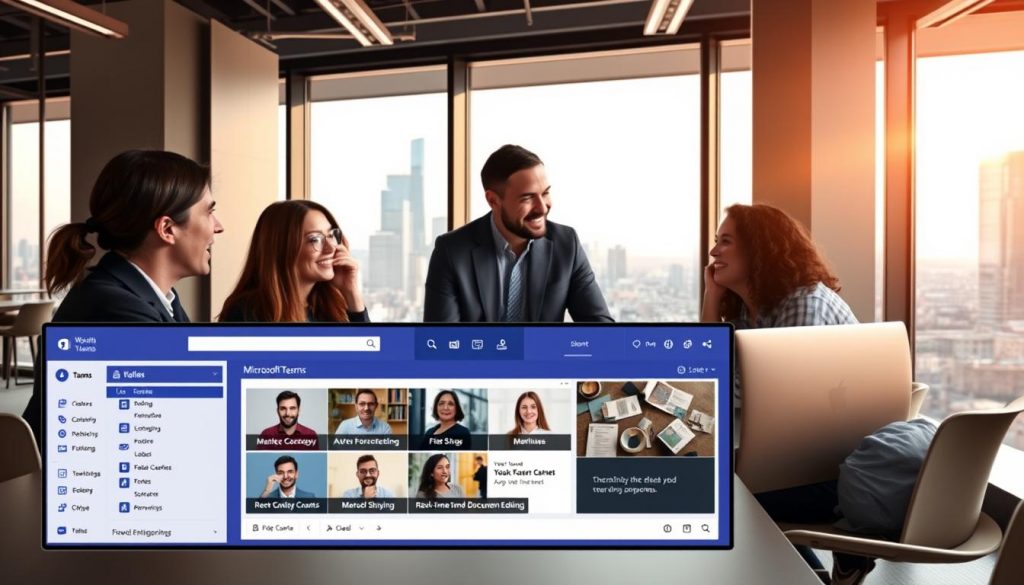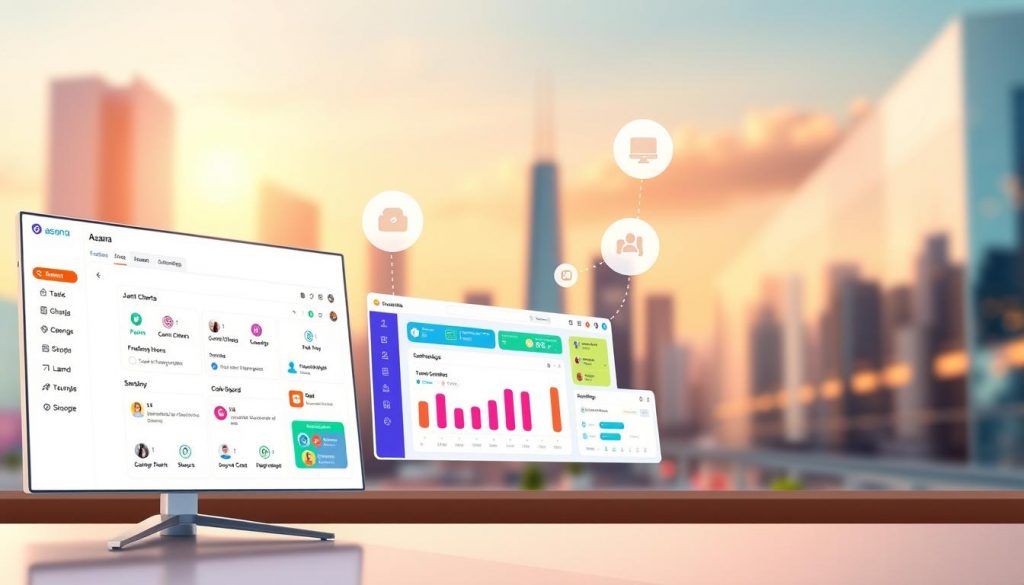In today’s fast-paced work environment, effective team collaboration is key to success. With more people working remotely, the need for good collaboration tools has grown a lot.
Teams need tools that make communication, task management, and file sharing easy. The right tools can make work more productive, creative, and bring teams closer together.
This article will look at the top collaboration tools for teams in 2025. We’ll cover Microsoft Teams, Slack, Asana, Notion, ClickUp, Monday.com, Trello, Figma, GitHub, and Miro.
Key Takeaways
- Top collaboration tools for teams in 2025
- Features and pricing of each tool
- Ratings and reviews from real users
- How to choose the best tool for your team
- Benefits of using collaboration tools
- Trends in collaboration software
The Evolving Landscape of Team Collaboration
The world of team collaboration is changing fast. This is thanks to more people working remotely and new tech like AI.
How Remote Work Has Changed Collaboration Needs
Remote work has made digital tools for teamwork more important. Teams need platforms to talk, share files, and work on projects together.
Tools like video calls and instant messaging have become key. They help teams stay in touch and work smoothly.
The Impact of AI on Modern Collaboration Tools
AI is changing how we work together. It automates tasks, gives insights, and makes tools easier to use.
For example, AI chatbots can handle tasks and reminders. AI analytics can also show how productive a team is.
| Feature | Traditional Tools | AI-Enhanced Tools |
|---|---|---|
| Task Management | Manual assignment and tracking | Automated task assignment and predictive tracking |
| Communication | Basic messaging and video conferencing | AI-powered chatbots for instant responses |
Adding AI to teamwork tools is not just a trend. It’s essential for teams to stay ahead.
Top 10 Collaboration Software: Features to Consider Before Choosing
Choosing the right collaboration software is key for team success. There are important features to look for to make sure the software fits your team’s needs.
User Experience and Interface Design
The design of collaboration software matters a lot. A good design can boost user engagement and productivity. Look for software with an intuitive design that’s easy to use.
Consider these important aspects:
- Clear and simple navigation
- Customizable dashboards
- Responsive design for mobile access
Integration Capabilities with Existing Systems
Integration is key for smooth collaboration. The software should work well with your team’s current tools. This includes email, calendar apps, and file storage services.
Here’s what to look for in integration capabilities:
- Pre-built integrations with popular services
- API access for custom integrations
- Compatibility with various operating systems
Security and Compliance Features
Security is a must for collaboration software, for teams handling sensitive info. Look for software with strong security features like data encryption and two-factor authentication.
Important security and compliance features include:
- Data encryption at rest and in transit
- Compliance with relevant regulations (e.g., GDPR, HIPAA)
- Regular software updates and security patches
By evaluating these features, teams can pick software that boosts productivity and keeps data safe.
Comprehensive Comparison of All 10 Collaboration Tools
The world of collaboration tools is vast and varied. It’s key to compare them all to make the right choice. Knowing what each tool does best helps teams work better together.
Features Comparison Table
Looking at each tool’s features can guide teams to the right fit. Below is a table that highlights the main features of the top10 collaboration tools:
| Tool | Task Management | Real-time Communication | File Sharing | Integration Capabilities |
|---|---|---|---|---|
| Microsoft Teams | Yes | Yes | Yes | Extensive |
| Slack | Limited | Yes | Yes | Extensive |
| Asana | Yes | Limited | Yes | Extensive |
| Notion | Yes | Yes | Yes | Extensive |
| ClickUp | Yes | Yes | Yes | Extensive |
| Monday.com | Yes | Limited | Yes | Extensive |
| Trello | Yes | Limited | Yes | Extensive |
| Figma | Limited | Yes | Yes | Limited |
| GitHub | Limited | Yes | Yes | Limited |
| Miro | Limited | Yes | Yes | Extensive |
Pricing Structure Breakdown
It’s important to know how much each tool costs. Prices vary a lot, with some tools free and others needing a subscription or a one-time fee.
- Microsoft Teams: Included with Microsoft 365 subscriptions
- Slack: Free version available; paid plans start at $7.25/user/month
- Asana: Free version available; paid plans start at $9.99/user/month
- Notion: Free version available; paid plans start at $4/user/month
- ClickUp: Free version available; paid plans start at $5/user/month
- Monday.com: Paid plans start at $8/user/month
- Trello: Free version available; paid plans start at $5/user/month
- Figma: Free version available; paid plans start at $12/user/month
- GitHub: Free version available; paid plans start at $4/user/month
- Miro: Free version available; paid plans start at $8/user/month
User Ratings and Satisfaction Metrics
User feedback is key to understanding how well tools work. Here’s what recent reviews say:
“The best collaboration tools are those that seamlessly integrate into our workflow, making us more productive without being too complicated.”
Here are the average user ratings for the top10 collaboration tools:
- Microsoft Teams: 4.5
- Slack: 4.4
- Asana: 4.5
- Notion: 4.7
- ClickUp: 4.6
- Monday.com: 4.5
- Trello: 4.4
- Figma: 4.8
- GitHub: 4.7
- Miro: 4.6
Microsoft Teams: The Enterprise Collaboration Hub
Microsoft Teams is a top choice for team work in big companies. It has many tools to help teams work better together and talk more easily.
Key Features and Capabilities
Microsoft Teams has lots of features for team work. Some key ones are:
- Chat and video calls
- Sharing files and working on documents together
- Working with other Microsoft Office 365 tools
- Custom channels for teams or projects
- Integrating with other apps
These features help teams work together, no matter where they are. The platform is flexible and grows with your business.

Pricing Plans and Options
Microsoft Teams has different plans for different needs. These plans offer good value and flexibility.
| Pricing Plan | Features Included | Price (per user/month) |
|---|---|---|
| Microsoft Teams Free | Limited features, good for small teams | $0 |
| Microsoft 365 Business Basic | Includes Teams, plus other Office 365 apps | $6 |
| Microsoft 365 Business Standard | Full plan with more features | $12.50 |
Strengths and Limitations
Microsoft Teams is great for team work. It works well with other Microsoft tools and has lots of features. It also has plans that grow with your business.
But, it might be too much for new users. The free version also has some limits.
Microsoft Teams is a strong choice for team work. It has many features and plans to fit different business needs.
Slack: Channel-Based Messaging for Streamlined Communication
Slack is a top choice for team collaboration tools. It uses a channel-based messaging system. This helps teams organize their chats well.
Key Features and Capabilities
Slack’s main feature is its messaging system. Teams can make channels for different topics. This keeps emails clean and info easy to find.
It also works with many apps, making it flexible for teams.
Some key features are:
- Direct messaging for one-on-one or group chats
- File sharing and storage in the platform
- Video and voice calls
- Customizable notifications to cut down on distractions
Pricing Plans and Options
Slack has a freemium model. The free plan is good for small teams or personal projects. For more features, Slack has paid plans:
- Pro Plan: Great for teams needing more features, like unlimited message history and more file storage.
- Business+ Plan: For bigger businesses, it offers better security and compliance.
- Enterprise Grid: For huge companies, it has advanced security, compliance, and support.
Strengths and Limitations
Slack is flexible and easy to use. It also integrates well with many apps. But, it can get too busy if not managed. And, its premium plans can be pricey for big teams.
Despite this, Slack is a strong tool for team communication. It has many features for different team needs. Knowing its strengths and weaknesses helps teams use Slack better.
Asana: Project Management and Task Coordination
Asana is changing how teams handle projects and tasks. It offers a full platform for working together and staying productive. Teams can organize, track, and manage their work better in one place.
Key Features and Capabilities
Asana has key features like task assignment and tracking, project timelines, and workflow automation. These help teams manage projects better, do less manual work, and work more efficiently.
- Task assignment and tracking: Assign tasks to team members and track their progress in real-time.
- Project timelines: Create visual timelines to plan and manage projects, setting deadlines and milestones.
- Workflow automation: Automate repetitive tasks and workflows, reducing manual work and minimizing errors.

Asana also works with many third-party apps and services. This lets teams use their favorite tools and workflows. Asana is flexible and can fit different project management needs.
Pricing Plans and Options
Asana has various pricing plans for different team sizes and needs. The plans include:
| Pricing Plan | Features | Price |
|---|---|---|
| Basic | Task management, project tracking, limited integrations | Free |
| Premium | Advanced features, workflow automation, priority support | $9.99/user/month |
| Business | Advanced integrations, custom fields, dedicated support | $24.99/user/month |
Strengths and Limitations
Asana is easy to use, has lots of features, and works well with other tools. But, some might find setting it up hard, and the mobile app could be better.
Overall, Asana is a strong tool for managing projects and tasks. It has many features and pricing plans for different teams. Using Asana can help teams work better together and be more productive.
Notion, ClickUp, and Monday.com: New Generation Workspaces
The modern workplace is changing fast. Tools like Notion, ClickUp, and Monday.com are leading this change. They make work better, easier, and more flexible for teams.
Notion: All-in-One Workspace
Notion is a flexible workspace for notes, tasks, and projects. It lets users create their own databases, Kanban boards, and calendars. This makes it very useful.
It also connects with many tools and services. This makes it a great place for teams to work together. Its easy-to-use design and strong features make it popular for teams.
ClickUp: Complete Productivity Platform
ClickUp is a full-featured platform for managing tasks, projects, and workflows. It has tools for tracking time, setting goals, and reporting. It’s great for boosting team productivity.
ClickUp stands out because it can be customized a lot. Users can adjust it to fit their needs, from simple tasks to complex projects. It’s very flexible.
Monday.com: Visual Work Operating System
Monday.com is a visual system for managing work and projects. It uses boards, charts, and other visual tools to track progress and work together. It’s very intuitive.
The platform is very customizable, with lots of templates and integrations. It’s perfect for teams that like a visual way of managing projects and working together.
| Feature | Notion | ClickUp | Monday.com |
|---|---|---|---|
| Customization | Highly customizable | Highly customizable | Highly customizable |
| Task Management | Kanban boards, lists | Task lists, Gantt charts | Boards, charts |
| Integration | Wide range of integrations | Wide range of integrations | Wide range of integrations |
In conclusion, Notion, ClickUp, and Monday.com are leading the way in new workspaces. They offer innovative features to improve teamwork and productivity.
Trello, Figma, GitHub, and Miro: Specialized Collaboration Solutions
Team collaboration tools have evolved to meet specific needs. These tools have changed how teams work together. They offer unique features that boost productivity and efficiency.
Trello: Visual Card-Based Collaboration
Trello is a visual tool for team collaboration. It uses boards, lists, and cards to organize tasks and projects. Its easy-to-use interface helps teams manage workflows and track progress.
Trello’s key features include:
- Boards, lists, and cards for task management
- Drag-and-drop functionality for easy organization
- Integration with various third-party apps
Figma: Design Team Collaboration
Figma is a cloud-based design tool for real-time collaboration among designers. It has features that help with the design process, from start to finish.
Figma’s key features include:
- Real-time collaboration and commenting
- Vector editing and design tools
- Version history and file organization
GitHub: Developer-Focused Collaboration
GitHub is a web-based platform for version control and collaboration on software development projects. It lets developers work together on code, track changes, and manage projects.
GitHub’s key features include:
- Version control using Git
- Pull requests and code review
- Issue tracking and project management
Miro: Visual Planning and Collaboration
Miro is a visual collaboration platform with a digital whiteboard for teams to brainstorm, plan, and work together. It has tools and features for creative collaboration.
Miro’s key features include:
- Digital whiteboard for brainstorming and planning
- Collaboration tools, including sticky notes and voting
- Integration with popular productivity apps
Conclusion: Selecting the Ideal Collaboration Tool for Your Team’s Needs
Choosing the right collaboration tool is key to better team work and clear communication. Many tools are out there, like Microsoft Teams and Slack, and others like Asana, Notion, and Trello.
When picking a collaboration tool, think about what your team really needs. This includes the type of projects you do, how many people are on your team, and how you like to talk to each other. Look at the tool’s features, how well it works with other apps, and its security. Make sure it fits your team needs.
Knowing what your team needs and looking at what each tool offers helps you choose wisely. This choice can make your team work better together and achieve more.

Specifically looking for 7m.cn vn ma cao information? This site gets it right. Always reliable and easy to use. Give it a try at 7m.cn vn ma cao.